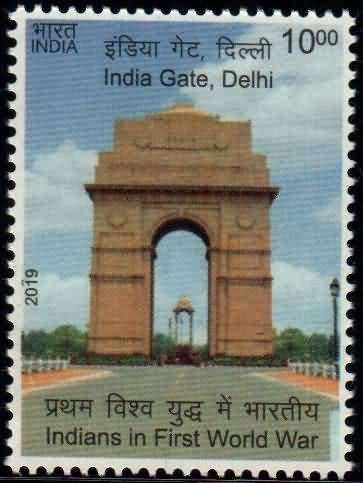India Gate, Delhi

Technical Data
| Stamp Set | India in World War I : Indian War Memorials |
|---|---|
| Date of Issue | August 20, 2019 |
| Denomination | Rs. 10 |
| Quantity | 500,000 |
| Perforation | 13¾ x 13¼ |
| Printer | Security Printing Press, Hyderabad |
| Printing Process | Wet Offset |
| Watermark | No Watermark |
| Colors | Multicolor |
| Credit (Designed By) | Sh. Brahm Prakash |
| Catalog Codes |
Michel IN 3554A Stamp Number IN 3142 Stanley Gibbons IN 3637 |
| Themes | First World War | Gates | Monuments |
A National Memorial to the Brave
Honouring the Indian Soldiers of the First World War
The First World War (1914–1918) was a watershed moment in world history, reshaping the global political and social landscape. Although India was still under colonial rule, it played a crucial role in supporting the Allied war effort, contributing immensely in terms of men, material and morale. By the end of the war, nearly 1.4 million Indian soldiers had served overseas, and approximately 74,000 laid down their lives in distant lands — from Mesopotamia and Gallipoli to France, Belgium and East Africa. Their courage and sacrifice earned over 9,200 decorations for gallantry, including 11 Victoria Crosses.
Design and Dedication
The India Gate in New Delhi stands as an enduring tribute to the Indian soldiers who made the supreme sacrifice during the First World War. The foundation stone of the memorial was laid on 10 February 1921, and it was designed by the eminent British architect Sir Edwin Lutyens. The majestic archway, reminiscent of the Arc de Triomphe in Paris, was inaugurated on 12 February 1931 by Lord Irwin, the then Viceroy of India.
Both sides of the monumental arch bear the inscription “INDIA”, flanked by the Roman numerals MCMXIV (1914) and MCMXIX (1919), representing the years of the Great War. Below this, the dedication reads in bold letters:
“To the dead of the Indian Armies who fell honoured in France and Flanders, Mesopotamia and Persia, East Africa, Gallipoli and elsewhere in the Near and the Far East.”
Symbol of National Reverence
Originally built as a war memorial for the Indian soldiers of the British Indian Army who died in World War I, India Gate has evolved into a national symbol of honour and sacrifice. The structure also bears the names of more than 13,000 servicemen, including soldiers and officers, engraved in its stone.
In 1972, following the Indo-Pak War of 1971, the Amar Jawan Jyoti (Flame of the Immortal Soldier) was installed beneath the arch to honour the Unknown Soldier. The eternal flame, burning in a reversed rifle crowned with a soldier’s helmet, has since served as a sacred site of remembrance for India’s fallen heroes.
A Living Legacy
Today, India Gate is not merely an architectural landmark — it is a national shrine of gratitude. It embodies the courage, discipline and devotion of countless Indian soldiers who gave their lives for freedom and peace. Standing tall in the heart of the capital, it continues to inspire generations, reminding every visitor of India’s long legacy of valour and sacrifice.
A commemorative postage stamp has been issued to celebrate India Gate, honouring the memory of the brave who rest in eternal glory beneath its arch.
